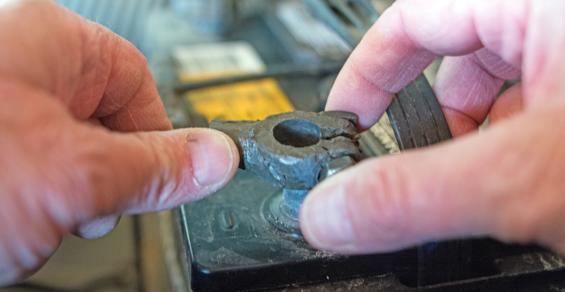Before parking the tractor in the shed, work through this battery health checklist.
Taking care of your farm equipment batteries over winter can mean a quicker, smoother start to spring planting.
It is common that batteries lose power as temperatures turn colder. But why?
“Batteries work through an internal electrochemical reaction, which will send power to the terminals,” explains Josh Goldsworthy, product manager for batteries at Case IH Genuine Parts. “So, in cold weather, this chemical reaction actually slows down, and that is what reduces the power of the battery. The electrolyte viscosity and the resistance inside of that battery are increased as the temperatures of the electrolytes drop.”
For instance, when a temperature drops below 32 degrees F, the battery will likely only deliver about 75% of its capable power, Goldsworthy says. In more extreme temperatures, around zero degrees, that power delivery could actually reduce to 40%.
A battery needs to be kept as close to full charge as possible in the winter because it will keep the internal battery chemistry at an optimal performance. If it is not fully charged or allowed to drain down completely, the inside chemistries start to resemble properties closer to water.
In that state, the inside of the battery can freeze and damage the internal plates, which Goldsworthy says ultimately reduces battery performance and can lead to total battery failure.
Proper care for batteries
Here are a few maintenance tips from Goldsworthy to keep batteries in optimum condition this winter. Following these can help you avoid equipment failure and poor machine performance:
Inspect. Visually assess the battery to see if there are any cracks or damage. Goldsworthy notes that any leakage can be very dangerous because of the chemicals inside the battery.
Test. Using a simple battery tester check for voltage and cranking amps.
Clean. If storing your battery in the machine, Goldsworthy says it is important to clean off the top part of the battery. “Those batteries can collect chaff, leaves or dust during harvest, which can also allow moisture to collect,” he explains. Moisture creates a conductive path that can drain the battery faster.
Brush. Terminals need to be clean from corrosion. Use a terminal brush and terminal cleaner for best results. “You need a really clean contact to give you the most consistent power supply, whether starting the machine or hooking up to a battery maintainer,” Goldsworthy says.
Charge. Charging a battery keeps it from freezing. A battery maintainer works automatically to provide that charge, so you can leave them on as long as you need. It shuts off when the battery is fully charged. When it detects a drop, it will kick back on, but it will not overcharge. If you’re not removing your battery and it’s going to be stored in the cold, Goldsworthy says, “It’s really important to have a maintainer on it, or at the very least, check it periodically with a portable charger.”
Store. The ideal condition is to store batteries inside a warm place connected to a maintainer. “That will leave it in a full state of charge, and you’ll avoid any potential freezing,” Goldsworthy adds.
Built for farming conditions
When it comes to farming, the type of battery matters. Case IH has its own heavy-duty batteries designed to meet farming’s rugged conditions.
“They’re designed for off-road, heavy-duty use, and tested to ensure that the vibration resistance that battery can withstand will exceed those of a standard aftermarket battery,” Goldsworthy explains.
HEAVY DUTY: It takes the strong battery inside and out to keep up on the farm. Case IH developed its MagnaPower batteries to handle the rigorous work.
Typically, he notes, aftermarket batteries will only partially anchor the plates in the battery to the actual battery itself. “But our MagnaPower batteries, we completely anchor those plates to the bottom with an epoxy to make sure that those plates are protected to the max against things like jolts and vibration, which can cause damage to inside plates and will degrade the battery over time.”
Winter may be the time to swap out batteries. “A high-quality battery can give you the confidence to know heading into winter if you’re going use that piece of equipment, you’ll have a healthy battery,” Goldsworthy adds, “or if you’re heading into storage and you properly maintain it, you’ll know in the spring when you pull it out that you have a healthy battery, so you can hit the ground running right away.”




